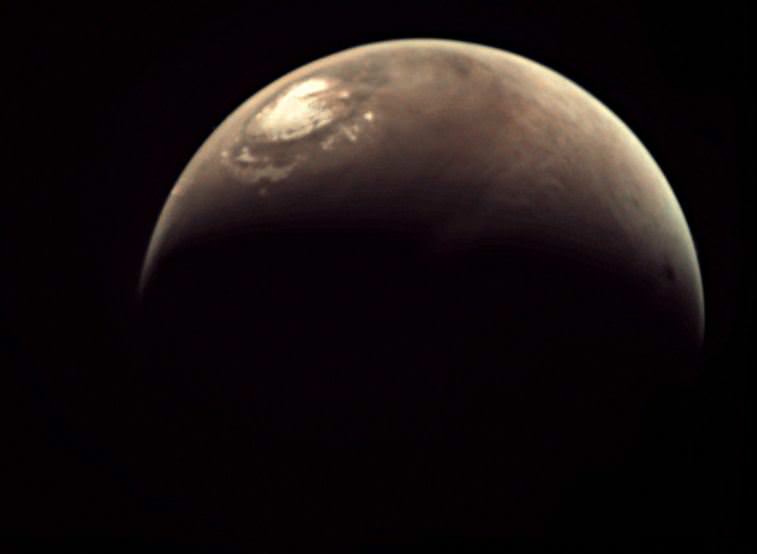Future human Mars mission preview! The team from Mars Express put this great video together which shows what Mars looks like from above, during an elliptical orbit. They created it using 600 individual still images captured by the Visual Monitoring Camera (VMC), and it shows the view from a visiting spacecraft’s slow descent from high above the planet, then speeds up during closest approach, and then slows down again as the orbital distance increases.
A Mars Express VMC camera image of Mars from May, 2012. Credit: ESA
Visible are giant Martian volcanoes, a quick glimpse of the ice-covered South Pole, and Mars terminator as day turns to night. Then quickly daylight returns, and then the visitor sees the North Pole, followed by the long climb away from the planet over the equator. Finally, at the end of the movie — look closely! –the disk of Phobos can be seen crossing over Mars.
The VMC is being used almost like a Mars webcam! It consists of a small CMOS-based optical camera, which can be fitted with an on-pixel RGB color filter for color images. So, it is basically an ordinary camera, but it is in an extraordinary place! It originally provided simple, low-tech images of Beagle lander separation — a mission which, unfortunately failed and crashed. But the VMC has been resurrected to provide views of the Red Planet. It’s not a scientific instrument, but it does provide fantastic views of Mars – including crescent views of the planet not obtainable from Earth.
The images used here were taken during Mars Express’ 8,194th orbit of Mars on May 27, 2010 between 02:00 and 09:00 UTC (04:00-11:00 CEST).


one question I have is how dark is Mars considering its distance to the Sun… even in midday it should be darker than what we see in photographs from Curiosity, Spirit, etc…or our eyes would adapt accordingly?
it is darker but still brighter than it is on Earth during cloudy day.
Some of Mars Express’ images are amazing
Pretty cool! I watched the video first before reading and thought it was CGI. 😛
This video gave me a little feel for what it would be like, in final leg of long voyage, on journey so far from home, approaching a momentous landfall of a great adventure: a new world for men to explore and discover (though thanks to robotic pioneers, not so unfamiliar as the mysterious old worlds of sailing ships gone by, vanished in the mists of time).
I could almost imagine the excitement of final approach: the dramatic realization of the dreams of generations past (with a whole neighboring world watching breathless), yet also feel the sobering–gripping–realization of entering a forbidding, inhospitable, and unforgiving realm, far from man’s life-nurturing Homeworld.
Imagine, the fulfillment of the dream of past generations materializing for a select few, as they make their final approach to Mars–the long beckoning world of myth and Science–in final leg of long journey. The mounting excitement of a momentous–and dangerous–landfall, a whole new world to explore and discover. Thanks to robotic pioneers gone before, not so unfamiliar as the old worlds of sailing ships gone by, into mists of time, vanished.
Gave me a sense of what those spacefarers might feel, as this old, yet new world filled their ship’s horizon: the materialization of a long worked towards vision, yet also, the sobering–gripping–realization of entering a forbidding, inhospitable, unforgiving planetary realm, fearfully distant from their life-nurturing Homeworld.
The courage of vision will be required to dare to risk all in stepping-out to embark on that star-canopied journey!
tinyurl.com/cyk9xz2